Let’s Talk!
I have always been skeptical of the common horoscope column in magazines and newspapers. Although my Sun sign is Aries, I have never been able to recognize myself as the impulsive and unfocused Aries women that is often described. You may also have noticed that many individuals in your circle of family and friends may share the same Sun sign, but have very different personalities traits.
Recently, an acquaintance of mine produced my birth chart using a computer software based on the Vedic astrology (or Jyotish) system. I told him my date of birth, my city of birth (latitude and longitude), my exact time of birth, and time zone adjusted for daylight saving time. Â I was very surprised by the accuracy of my chart; it was the first time that I was able to read what sounded like a more truthful description of myself in various areas of my life.
This first experience with birth charts spiked my curiosity. I began to wonder about the specific placement of planets and stars at birth and their influence on aspects of our relationships. Also, are there other forces that influence our behaviour in these relationships?
Letâs begin our inquiryâ¦
The word horoscope comes from the Greek word horoskopos meaning âa look at the hoursâ. In astrology, a horoscope is a diagram representing the positions of specific celestial bodies, aspects, and angles at the time of an event such as a personâs birth (See diagram below).
Nowadays, a personâs Sun sign zodiac placement is used to predict personality traits, which is limited compared to the comprehensive traditional horoscope approach. Although it is recommended to consult an experienced astrologer to create a detailed birth chart, you can map the location of key celestial bodies at your birth to discover your deeper nature.
The 12 zodiac signs are classified in four elements: Fire (Aries, Leo, Sagittarius); Earth (Taurus, Virgo, Capricorn); Air (Gemini, Libra, Aquarius) and Water (Cancer, Scorpio, Pisces). Each element reflects a particular personality trait: Earth is common sense; Fire is action orientation; Air is thought and communication; and Water is feeling and intuition. If there is too much of one element in a birth chart, the individual will tend to overly express that personality trait.
In terms of understanding who we are in relationships, the placement of the Sun, Moon, Mars and Venus can give us many clues.
The Sun placement indicates our basic nature and what we are trying to become in this lifetime. It also tells us how we relate to people in general. Our Sun sign is a masculine/yang principal that represents our will, vitality and creative force directed outward.
The Moon placement denotes how we express and deal with our emotions. It is a feminine/yin principal that reveals our inner most emotional needs and how we nurture ourselves. The Moon sign is a passive feminine energy directed inwards.
The Mars placement stands for what triggers a boost of energy, what makes us angry, and how that anger is expressed. It is the seat of our deepest animal desires and how we try to satisfy those desires. The Mars sign is therefore a masculine/yang principle directed outwards.
The Venus placement represents how we interact in our close relationships – that is, love, attraction and marriage. It is a feminine/yin principle that describes how we appreciate beauty and esthetics in general. The Venus sign is a passive inward directed energy.
Itâs important to point out that if your Venus and Sun are in different sign, it means that you may treat people in your romantic life differently from people in general.
To find out the effect of different combinations of Sun/Moon and Mars/Venus on a personâs personality traits, check these links:
The American Psychiatrist and spiritual teacher Dr. David R. Hawkins uncovered some interesting information to find deeper, more hidden characteristics of human behaviour beyond astrology. After 20 years of kinesiology-based research, Hawkins came up with a map of human consciousness that describes levels of awareness that range from shame to enlightenment.
You can check this map here.
According to Hawkins, only about 4% of the world population is spiritually advanced or lives in a continuous state of love. The vast majority of people (96%) live mostly in lower levels of consciousness or unconscious fear. Hawkins also underlines the fact that levels of human consciousness are set at birth, and are very stable throughout a personâs lifetime. A personâs consciousness is reflected in how they perceive, understand, and experience the world.
For example, at lower levels of consciousness, love is perceived as an external precious commodity that has to be earned and consequently can be lost. At much higher levels of consciousness, unconditional self-love is a state of infinite inner peace totally separate from the presence of a lover.
Levels of human consciousness may have a profound effect on personality traits. At lower levels of consciousness, the negative versions of these traits are often expressed. For instance, confidence becomes arrogance; determination becomes stubbornness, and devotion becomes possessiveness. In a relationship, two individuals may theoretically have compatible birth charts, but if they are at very different levels of consciousness, the relationship may fail.
Human nature is very complex. A detailed birth chart can open a window to unacknowledged parts of our personality. Most importantly, we can better understand our behaviour in many relationships â especially romantic ones. However, other forces are at work, and levels of human consciousness may be a key factor. Regardless of what some may say, certain answers can definitely be found in the stars.
Literary Truths
You can generate your birth chart based on the Vedic Astrology system here. Just scroll down the page.
Please ensure that you have a java-enabled browser while trying to view this birth chart. This system works on:
*Windows 2000, Internet Explorer 5 and above with Microsoft Java Virtual Machine.machine
*Windows 2000 and XP, Internet Explorer 6 and above with Java xRuntime Environment Version 5.0 Update 6
*Windows 2000 and XP, Firefox 1.0.8 and above with Java Runtime xEnvironment xVersion 5.0 Update 6
You can download java from Java Download Link.
This application is known not to work on Mozilla and Netscape browsers on Linux machines.
Procedure:Letâs take the example of Joe who was born on March 21, 2010 in Toronto, Canada at 1:00 am.
- Enter the date of birth in the format DD-MM-YYYY. i.e., enter 21 04 2010. There seems to be a glitch in a few Vedic Astrology computer software that I have checked. When you enter the month, use the reference table below. Aries=04 or 05; Taurus=05 or 06; Gemini=06 or 07; Cancer=07 or 08; Leo=08 or 09; Virgo=09 or 10; Libra=10 or 11; Scorpio=11 or 12; Sagittarius=12 or 01; Capricorn=01 or 02; Aquarius=02 or 03; Piscies=03 or 04
- Enter the time of birth in 24-hour clock. Unknown=12:00 pm xxi.e., enter 1 00 if the birth time is 1:00 am enter 13 00 if the birth time is 1:00 pm
- Enter the time zone (the difference between your countryâs standard time and Greenwich Mean Time or GMT) i.e., enter 5 00 W because Canada is 5 hours West of Greenwich, England. You can try a lower (4) or a higher number (6) to see if the chart produced describes you better.
- Enter the latitude and longitude of the city of birth. i.e., enter latitude 43, 40N, and longitude 79, 25W for Toronto.
- Keep the chart type as âNorth Indianâ.
- Click on âcalculateâ.
Here is a list of reference tables:
Daylight saving time chart based on birth city
Latitude and longitude of birth city
References
The Four Elements (Fire, Earth, Air, Water)
Hawkins, David R. Power Versus Force. Carlsbad: Hay House, 2009.
Moon
Venus
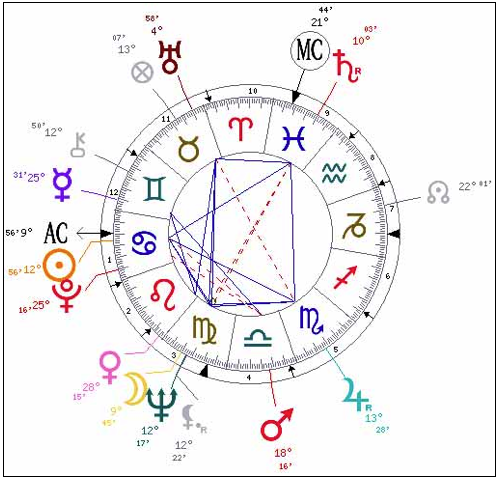
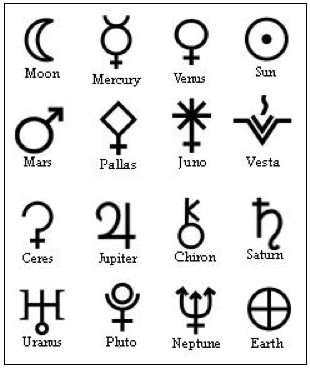
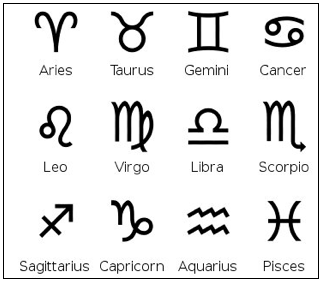
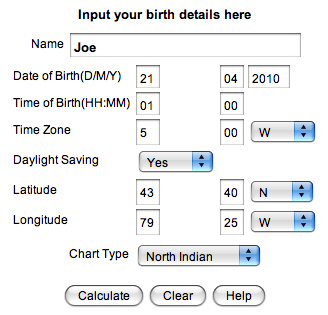
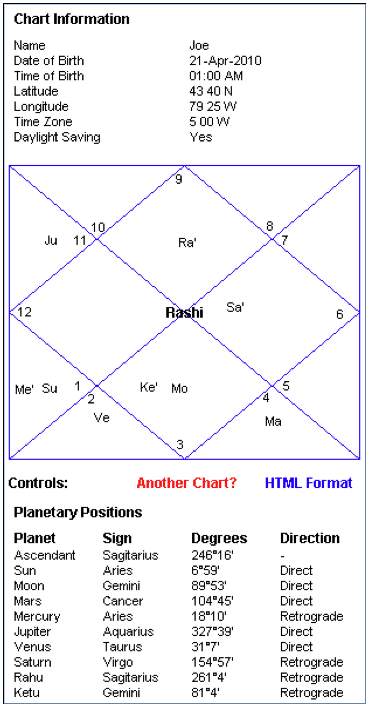
Hey, could I quote some of the information from this blog if I reference you with a link back to your site? See ya.
Thank you for visiting my blog. You can use only short referenced quotes (i.e., a few sentences) or paraphrase my ideas.
Regards,
J.M.
Thank you very much for a fantastic blog. It’s been the salvation of my webpage.
Very impressive blog.
I need to subscribe to this blog – great post. Found it on Google.
Pingback: alignment of planets, important events | 2012 news from around the globe
Thanks for sharing all of this, I’ve read this on my iphone in the train! Haha.
It’s great to visit your website again – I’ve been doing so for several weeks.
Nice theme, did you design it for yourself? Really looks great!
I really enjoyed reading your post. It was very informative and I also digg the way you write! Keep it up. I’ll be back to read more.
I really loved your post, thanks for sharing.
This is the right blog for anyone who needs to find out about this topic. Great stuff!
I don’t entirely agree with you on this.
I like this site very much. It’s a very nice weblog to read and find info.
Extremely cool, some great points! I appreciate that you made this article available. The rest of the site is also well done. I hope you have a great day.
Your website is valuable to me. Thanks!
You should take part in a contest for one of the best blogs on the web. I will recommend this site!
I love the fact that a lot more people are now investing far more time writing on the internet, instead of only sitting back again and reading what other people wrote.
I normally don’t leave comments on blogs, but your writing forced me to so. Amazing work.
There is obviously a ton to know about this. I think you made some valid points in this post.
This is so great that I had to comment. I’m usually just a lurker, taking in knowledge and nodding my head in quiet approval at the good stuff…..this required written props. Theory rocks…thanks.
I have a problem with the overall premise of your post, but I still think it’s really informative. I really like your writing style. Keep up the good work.
I really enjoyed reading these articles. They are all well written and interesting.
Good to know people still care.
Interesting!
This is a great article. Thanks a lot for posting and keeping the site active, I read all the time!
This is excellent. I come here all the time, and it’s posts like this one that is the reason. 🙂 Keep up the great work.
This article is captivating and it made me think.
Thanks for making an honest attempt at providing an explanation for this. I hope that as you gain more in depth knowledge of this topic, you will add more posts similar to this one. It will be very useful for me and my colleagues.
Good post, bookmarked! (also did a Digg submit for you 😉 )
I don’t know how anyone can read this and not think “genius alert”. Great work. I’ll keep coming back to read even more.
Extremely good blog post. If there were more authors like you, I’d have more blogs to check out when I go online. Haha.
I’m glad to be a visitor of this site! Thanks for this rare information!
Great site. A lot of useful information here. I’m sending it to some friends!
Nice site, easy on the eyes, and great content.
Great post, thank you!!!
I actually love some posts here, thanks for your time.
Thanks for the great read!
Hi there. You’ve done an excellent job. I will definitely digg it, and personally suggest it to my friends. I’m confident they will benefit from this site.
Great article, very useful for me. Thank you.
Thank you for this blog. You’ve made this blog into something that’s eye opening and critical. You clearly know a lot about this subject, and you’ve covered several aspects. Wonderful stuff.